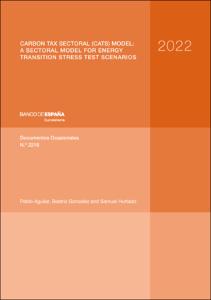Carbon tax sectoral (CATS) model: a sectoral model for energy transition stress test scenarios
Authors
Issue Date
13-Sep-2022
Physical description
53 p.
Abstract
Este artículo presenta un modelo de equilibrio general diseñado para producir escenarios macroeconómicos que incorporen los riesgos de transición asociados a las políticas adoptadas para evitar el proceso de cambio climático (no los riesgos físicos asociados al coste del cambio climático a largo plazo). El modelo está calibrado para la economía española, y puede simular el impacto de shocks en el precio y la cobertura de derechos de emisión de gases efecto invernadero, con particular atención a las asimetrías sectoriales provenientes de i) la intensidad de uso de la energía; ii) la fuente de dicha energía, y iii) las interdependencias entre industrias. Mostramos que, tras un incremento en el precio de los derechos de emisión similar al observado en los últimos años (de aproximadamente 25 € por tonelada de CO2 en 2019 a casi 100 € por tonelada en 2022), el modelo predice una caída acumulada del PIB después de tres años del 0,37 %. La pérdida de valor añadido es muy heterogénea entre distintas industrias, con valores que van de pérdidas del 4 % en las industrias más afectadas a un impacto prácticamente nulo en los sectores menos afectados. En relación con el uso del modelo para pruebas de estrés, esta heterogeneidad apunta a la existencia de riesgos potenciales para la estabilidad financiera, y a la importancia de una correcta diversificación bancaria para disminuir su exposición a los riesgos de transición.
This paper presents a general equilibrium sectoral model designed to produce macroeconomic scenarios that incorporate transition risks associated with policies to curb climate change (but not physical risks associated with the long-term costs of climate change). The model is calibrated to the Spanish economy, and can simulate the impact of shocks to the price and coverage of greenhouse gas emission allowances, with particular attention to sectoral asymmetries arising from (i) the energy intensity of each industry, (ii) the source of that energy, and (iii) the interdependencies with other industries. We show that for an increase in the price of emission allowances similar to that observed in recent years (from approximately €25 per tonne of CO2 in 2019 to almost €100 per tonne in 2022) the model predicts a cumulative decline in Spanish GDP after three years of 0.37%. The loss in value added is very heterogeneous across industries, ranging from 4% in the most severely affected industries to virtually no impact in the least affected industries. In terms of the use of the model for stress testing, this heterogeneity points to potential risks for financial stability and the importance of the right diversification for banks to diminish their exposure to transition risks.
This paper presents a general equilibrium sectoral model designed to produce macroeconomic scenarios that incorporate transition risks associated with policies to curb climate change (but not physical risks associated with the long-term costs of climate change). The model is calibrated to the Spanish economy, and can simulate the impact of shocks to the price and coverage of greenhouse gas emission allowances, with particular attention to sectoral asymmetries arising from (i) the energy intensity of each industry, (ii) the source of that energy, and (iii) the interdependencies with other industries. We show that for an increase in the price of emission allowances similar to that observed in recent years (from approximately €25 per tonne of CO2 in 2019 to almost €100 per tonne in 2022) the model predicts a cumulative decline in Spanish GDP after three years of 0.37%. The loss in value added is very heterogeneous across industries, ranging from 4% in the most severely affected industries to virtually no impact in the least affected industries. In terms of the use of the model for stress testing, this heterogeneity points to potential risks for financial stability and the importance of the right diversification for banks to diminish their exposure to transition risks.
Publish on
Documentos Ocasionales / Banco de España, 2218
Subjects
Cambio climático; Pruebas de estrés; Matrices insumo producto; Climate change; Stress test; Input-output matrix; Recursos naturales y medio ambiente; Energía y política energética; Política fiscal
Appears in Collections:












